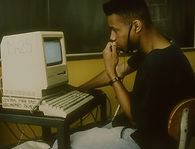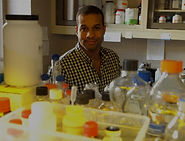01. Foundations Of Discovery
02. The Logic Of Drug Discovery
03. Why I Also Care About Consumer-Packaged Goods
04. Taking Risk
05. The Cost of Discovery
06. Beyond Lab
foundations of discovery
i was born in 1974, Generation X.
As a child, nuclear war seemed imminent. HIV reshaped public health, and the Space Shuttle Challenger exploded on live television. Like many latchkey children, I came home from school with a key in hand. On the Upper West Side, Harlem, and Washington Heights in 1980s New York City, I learned independence early: cooking, caring for siblings, and figuring things out. No one was there to show me how.
I attended Central Park East Secondary School, founded by Deborah Meier in Spanish Harlem. There, learning was built around her Five Habits of Mind: asking for evidence, questioning assumptions, seeing multiple perspectives, drawing connections, and testing ideas for significance. Education was inquiry, not instruction. I learned that thinking is an active process. Curiosity and skepticism became tools, not traits.
Later, I was drawn to Bard College. Its mixed focus on chemistry, art, and philosophy showed me how structure,whether molecular or conceptual, shapes behavior. Bard’s open dialogue and cross-disciplinary approach reinforced that ideas live best when tested from multiple directions.
Years later, in 2003, I found myself at Columbia University. I worked under Koji Nakanishi, whose creativity and discipline defined modern natural-products chemistry. Koji was the first mentor with whom I shared a true connection. From Koji, I learned that discovery is not just analysis—it is design. His work ethic and joy in experimentation showed me how rigor and imagination can coexist. Science, when practiced with intent, becomes a form of artistry.
At Columbia, I also had the guidance of Nicholas Turro. He would say scientists can be the least open people to new ideas because they spend their lives defending one or two. But, he insisted, to be a true scientist, you must be willing to accept that everything you’ve done could be wrong. That lesson stayed with me. Humility, I realized, is not a weakness in science—it is its foundation.
New York City at the time was called the “crime capital of the world.” Growing up between nuclear anxiety and the rise of MTV and hip-hop, I witnessed the collision of control and chaos. These contrasts shaped my philosophy: progress is fragile but essential, and the path to understanding always runs through uncertainty.
the logic of drug discovery
by the time I began research at UCLA in 1998, drug discovery itself was in transition. Back then, natural-products chemistry—studying molecules shaped by evolution and refined by medicinal chemistry—still guided discovery. But new tools were on the horizon.
At UCLA, I studied computational chemistry with Ken Houk. Quantum chemistry and computers made it possible to predict the behavior of molecules. For me, this wasn’t a rejection of wet chemistry but an expansion—an evolution from glassware to algorithms. The discipline was moving from the tangible to the theoretical, and I was moving with it.
Soon, automation arrived. High-throughput screening and combinatorial chemistry promised to replace insight with scale and turn discovery into a statistical exercise. Shortly after, genomics reframed biology as information. Sequencing the human genome created the belief that every disease had a genetic address and every gene a druggable target. Now, machine learning and artificial intelligence extend those hopes further. They offer prediction, pattern recognition, and speed beyond human reach.
With each wave of technology, new power emerged. Yet, none has replaced the need for understanding. Discovery always begins with a question, a hypothesis, and the courage to test it. The tools for drug discovery evolve. The promises change. Yet, the act of discovery remains the same: understanding before building, thinking before testing.
In my work, I try to integrate these tools (from genomics to AI) but keep them focused on sharpening hypotheses, not replacing them. Rational drug design remains central to my approach because it always begins where meaningful discovery begins: with a mechanistic understanding of biology.
I invent through a method called rational design. Rational design depends on an understanding of the molecular processes involved in the problem being addressed, knowledge of molecular behavior and chemical design, and an ability to predict how foreign molecules might interact with these processes to inhibit or correct them. The problem could be anything. However, I use rational design for disease mitigation and developing consumer packaged goods.





why i also care about consumer-packaged goods
my interest in consumer packaged goods is historical. Many of the earliest pharmaceutical companies — Merck, Bayer, Pfizer, Johnson & Johnson — began with what we would now call consumer products: cough syrups, plasters, dyes, citric acid, lactic acid. These early ventures generated steady revenue and built the infrastructure that later made scientific discovery possible. The same opportunity exists today.
Consumer packaged goods serve immediate human needs and create value, enabling exploration. Revenues provide the foundation for speculative scientific work — the kind of experiments that shift paradigms.
Most experiments test what we already understand; risky experiments question the framework itself. Results may have no immediate application, but they have profound potential once their meaning becomes clear. Their value lies not in utility, but in possibility.
Our own speculative research into the ability of mammalian cells to generate energy (ATP) from ambient light led to a small-molecule diabetes intervention — an example of how curiosity-driven exploration can yield practical breakthroughs. Consumer packaged goods allow for play — and play fuels discovery.
taking risk
risk is a responsibility. Discovery requires someone willing to risk their resources on uncertainty in pursuit of a possibility. Science advances when individuals invest in outcomes that convention deems unlikely. Those with stability and resources thus have a moral duty to take risks. Those with stability and resources can take on uncertainty that would be catastrophic for others. Risk transforms asymmetrical privilege into progress, converts inequality into advancement.
the cost of discovery
my early years in science were exciting, but they also carried an emotional weight that I still feel today. I was trying to build new ideas with almost no safety net, and the environment around me often made that harder. As a chemist working with viruses, animal models, and disease biology, I didn’t fit anyone’s expected category. The response to that mismatch could be harsh.
I built much of my early laboratory from equipment salvaged from closed-down units — incubators, hoods, instruments that other labs were throwing away — because no one would support the unconventional direction of my work. Instead of recognizing resourcefulness, colleagues laughed behind my back and treated it as proof that I didn’t understand how science was “supposed” to be done. Those reactions sting especially hard when you’re trying to create something new.
At night, when I worked at 2 or 3 a.m. in a quiet corner of the lab, security guards would sometimes approach and demand my ID because they assumed I didn’t belong there. Individually, moments like that seem small. But they accumulate. They shape how you see yourself. They make you question whether your ideas matter, or whether you’re simply out of place.
I tried to adapt. I changed the way I dressed, the way I spoke, even the way I carried myself, hoping it might make things easier. It didn’t. Even now, when I look through my old lab notebooks, I feel two parallel emotions: pride in the creativity those pages contain, and pain from what it took to generate them. That mixture hasn’t fully disappeared. Healing takes time.
But the ideas survived. And surviving matters. Those notebooks remind me that persistence can outlast doubt, and that curiosity can outlast difficult environments. They remind me that good ideas often start in places where they are not understood at first.
These experiences shape how I work. They made me someone who listens closely to unconventional ideas — especially the ones that don’t yet have a home. I devote time to mentoring because I know what it feels like to push forward without support. I know what it means to believe in something before anyone else does.
I learned that innovation needs encouragement, patience, and someone willing to say:
“Keep going. Your idea matters.”
I didn’t always have that.
Now I try to be that person for others.
beyond the lab
outside the lab, I’m drawn to things that seem impossible. Rock climbing, weightlifting, and movement all begin with a challenge that looks beyond reach — an impossible ascent, a weight too heavy, a stretch that seems unattainable. With patience and repetition, what once felt out of reach becomes routine. That process is a compressed version of discovery: struggle, adaptation, then clarity.It’s a reminder that progress, in science and in life, doesn’t come from certainty. Progress comes from persistence and learning.
I find energy in stillness and in seeing patterns. Solitude helps me think. It’s where ideas take shape before they can be tested. Museums, libraries, and churches are some of my favorite places for reflection.
Bardzo interesujące
This is a good Ilyas